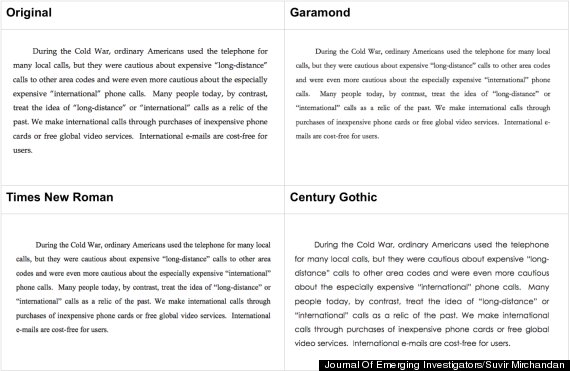What began as a middle-school student's science fair project could save the federal government millions of dollars -- and all it would require is a switch to a different font.
Fourteen-year-old Suvir Mirchandani has adapted his sixth-grader science fair project from Dorseyville Middle School in Pittsburgh -- a study of the cost savings incurred by switching the font in his school’s paper handouts -- to show exactly how much money the bigwigs in Washington, D.C., could save if they followed suit.
Spoiler alert: It's a lot.
His project showed that switching the school's paper font from Times New Roman to Garamond would save his school about $21,000 a year in ink costs. Spurred on by a teacher, Mirchandani submitted his research to the Journal of Emerging Investigators, which publishes the work of high school and middle-school students, CNN reported.
The journal's editors encouraged Suvir to see if the font switch would result in similar savings for the U.S. government, which according to the Office of Management and Budget has an estimated $1.8 billion printing budget for 2014.
“We were so impressed,” Dr. Sarah Fankhauser, the journal's founder, told Forbes. “We really could see the real-word application in Suvir’s paper.”
Suvir tested his font theory with five documents from the Government Printing Office (GPO) and concluded that switching the government documents' fonts from Times New Roman and Century Gothic (used on all government documents) exclusively to the more space-efficient Garamond would greatly cut costs in ink expenditure for both state and federal governments. The font point size remained the same in the study. He predicts the federal government would save roughly $136 million a year, and state agencies could collectively save up to $234 million annually.
![suvir mirchandani font project]()
The GPO in recent years has reduced its reliance on printed documents and is working to continue the switch to digital, Suvir told CNN he's confident his proposal is still relevant.
“They can’t convert everything to a digital format,” he said. “Not everyone is able to access information online. Some things still have to be printed.”
Fourteen-year-old Suvir Mirchandani has adapted his sixth-grader science fair project from Dorseyville Middle School in Pittsburgh -- a study of the cost savings incurred by switching the font in his school’s paper handouts -- to show exactly how much money the bigwigs in Washington, D.C., could save if they followed suit.
Spoiler alert: It's a lot.
His project showed that switching the school's paper font from Times New Roman to Garamond would save his school about $21,000 a year in ink costs. Spurred on by a teacher, Mirchandani submitted his research to the Journal of Emerging Investigators, which publishes the work of high school and middle-school students, CNN reported.
The journal's editors encouraged Suvir to see if the font switch would result in similar savings for the U.S. government, which according to the Office of Management and Budget has an estimated $1.8 billion printing budget for 2014.
“We were so impressed,” Dr. Sarah Fankhauser, the journal's founder, told Forbes. “We really could see the real-word application in Suvir’s paper.”
Suvir tested his font theory with five documents from the Government Printing Office (GPO) and concluded that switching the government documents' fonts from Times New Roman and Century Gothic (used on all government documents) exclusively to the more space-efficient Garamond would greatly cut costs in ink expenditure for both state and federal governments. The font point size remained the same in the study. He predicts the federal government would save roughly $136 million a year, and state agencies could collectively save up to $234 million annually.

The GPO in recent years has reduced its reliance on printed documents and is working to continue the switch to digital, Suvir told CNN he's confident his proposal is still relevant.
“They can’t convert everything to a digital format,” he said. “Not everyone is able to access information online. Some things still have to be printed.”